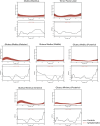Muscle Fat and Volume Differences in People With Hip-Related Pain Compared With Controls: A Machine Learning Approach
- PMID: 39343707
- PMCID: PMC11634488
- DOI: 10.1002/jcsm.13608
Muscle Fat and Volume Differences in People With Hip-Related Pain Compared With Controls: A Machine Learning Approach
Abstract
Background: Hip-related pain (HRP) affects young to middle-aged active adults and impacts physical activity, finances and quality of life. HRP includes conditions like femoroacetabular impingement syndrome and labral tears. Lateral hip muscle dysfunction and atrophy in HRP are more pronounced in advanced hip pathology, with limited evidence in younger populations. While MRI use for assessing hip muscle morphology is increasing, with automated deep-learning techniques showing promise, studies assessing their accuracy are limited. Therefore, we aimed to compare hip intramuscular fat infiltrate (MFI) and muscle volume, in individuals with and without HRP as well as assess the reliability and accuracy of automated machine-learning segmentations compared with human-generated segmentation.
Methods: This cross-sectional study included sub-elite/amateur football players (Australian football and soccer) with a greater than 6-month history of HRP [n = 180, average age 28.32, (standard deviation 5.88) years, 19% female] and a control group of sub-elite/amateur football players without pain [n = 48, 28.89 (6.22) years, 29% female]. Muscle volume and MFI of gluteus maximus, medius, minimis and tensor fascia latae were assessed using MRI. Associations between muscle volume and group were explored using linear regression models, controlling for body mass index, age, sport and sex. A convolutional neural network (CNN) machine-learning approach was compared with human-performed muscle segmentations in a subset of participants (n = 52) using intraclass correlation coefficients and Sorensen-Dice index.
Results: When considering adjusted estimates of muscle volume, there were significant differences observed between groups for gluteus medius (adjusted mean difference 23 858 mm3 [95% confidence interval 7563, 40 137]; p = 0.004) and tensor fascia latae (6660 mm3 [2440, 13 075]; p = 0.042). No differences were observed between groups for gluteus maximus (18 265 mm3 [-21 209, 50 782]; p = 0.419) or minimus (3893 mm3 [-2209, 9996]; p = 0.21). The CNN was trained for 30 000 iterations and assessed its accuracy and reliability on an independent testing dataset, achieving high segmentation accuracy (mean Sorenson-Dice index >0.900) and excellent muscle volume and MFI reliability (ICC2,1 > 0.900). The CNN outperformed manual raters, who had slightly lower interrater accuracy (Sorensen-Dice index >0.800) and reliability (ICC2,1 > 0.800).
Conclusions: The increased muscle volumes in the symptomatic group compared with controls could be associated with increased myofibrillar size, sarcoplasmic hypertrophy or both. These changes may facilitate greater muscular efficiency for a given load, enabling the athlete to maintain their normal level of function. In addition, the CNNs for muscle segmentation was more efficient and demonstrated excellent reliability in comparison to manual segmentations.
Keywords: Buttocks; Gluteal; Muscle; Pain.
© 2024 The Author(s). Journal of Cachexia, Sarcopenia and Muscle published by Wiley Periodicals LLC.
Conflict of interest statement
The content is solely the responsibility of the authors and does not necessarily represent the official views of the National Institutes of Health. Funding sources had no role in study design, collection, analysis, and interpretation of data, writing the report, or in the decision to submit the article for publication.
The authors declare no conflicts of interest.
Figures



Similar articles
-
The association between lateral hip muscle size/intramuscular fat infiltration and hip strength in active young adults with long standing hip/groin pain.Phys Ther Sport. 2024 Jan;65:95-101. doi: 10.1016/j.ptsp.2023.11.007. Epub 2023 Dec 12. Phys Ther Sport. 2024. PMID: 38101293
-
Leg Muscle Volume, Intramuscular Fat and Force Generation: Insights From a Computer-Vision Model and Fat-Water MRI.J Cachexia Sarcopenia Muscle. 2025 Feb;16(1):e13735. doi: 10.1002/jcsm.13735. J Cachexia Sarcopenia Muscle. 2025. PMID: 39972963 Free PMC article.
-
Muscle Size and Quality of the Gluteal Muscles and Tensor Fasciae Latae in Women with Greater Trochanteric Pain Syndrome.Clin Anat. 2020 Oct;33(7):1082-1090. doi: 10.1002/ca.23510. Epub 2019 Nov 24. Clin Anat. 2020. PMID: 31689358
-
Towards defining muscular regions of interest from axial magnetic resonance imaging with anatomical cross-reference: a scoping review of lateral hip musculature.BMC Musculoskelet Disord. 2022 Jun 4;23(1):533. doi: 10.1186/s12891-022-05439-x. BMC Musculoskelet Disord. 2022. PMID: 35658932 Free PMC article.
-
Visceral adiposity and inflammatory bowel disease.Int J Colorectal Dis. 2021 Nov;36(11):2305-2319. doi: 10.1007/s00384-021-03968-w. Epub 2021 Jun 9. Int J Colorectal Dis. 2021. PMID: 34104989 Review.
References
-
- Kemp J. L., Risberg M. A., Mosler A., et al., “Physiotherapist‐Led Treatment for Young to Middle‐Aged Active Adults With Hip‐Related Pain: Consensus Recommendations From the International Hip‐Related Pain Research Network, Zurich 2018,” British Journal of Sports Medicine 54, no. 9 (2020): 504–511. - PubMed
-
- Reiman M. P., Agricola R., Kemp J. L., et al., “Consensus Recommendations on the Classification, Definition and Diagnostic Criteria of Hip‐Related Pain in Young and Middle‐Aged Active Adults From the International Hip‐Related Pain Research Network, Zurich 2018,” British Journal of Sports Medicine 54 (2020): 631–641. - PubMed
-
- Neumann D. A., “Kinesiology of the Hip: A Focus on Muscular Actions,” Journal of Orthopaedic and Sports Physical Therapy 40, no. 2 (2010): 82–94. - PubMed
-
- Grimaldi A., “Assessing Lateral Stability of the Hip and Pelvis,” Manual Therapy 16, no. 1 (2011): 26–32. - PubMed
-
- Stewart C., King M. G., Kemp J. L., et al., “Hip Muscle Activity in People With Hip‐Related Pain Compared to Asymptomatic Controls: A Systematic Review,” Journal of Electromyography and Kinesiology 71 (2023): 102784. - PubMed
MeSH terms
Grants and funding
LinkOut - more resources
Full Text Sources

